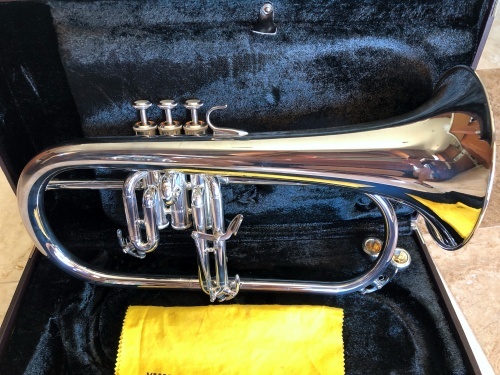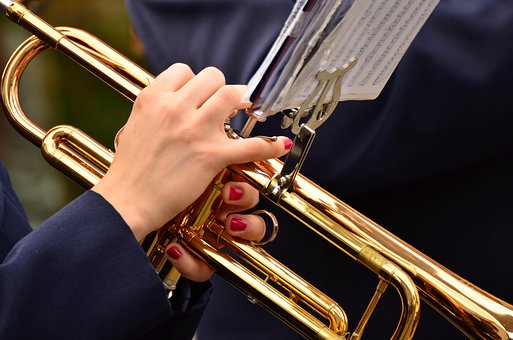Trumpets are designed to be held with the left hand around the valve cluster supporting most of the weight. Sorry if you are naturally left handed. That’s because your right hand has two purposes, first to depress the valves to change notes and second, to support the trumpet. This means that trumpets are designed for right handed players. The dexterity of your right hand is used to press the valves down to change notes (again, not great if you are naturally left handed). When a valve is “up” or not pressed, air flows through that valve to the next starting at the third valve. When you press the valve down, the air is routed through the extra tubing for that valve. As you can see from the pictures, the third valve (furthest away from the mouthpiece) has the longest extra tubing and the second (or middle) valve has the shortest.
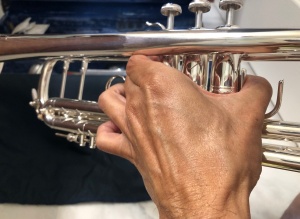
Hand Positions
Hold the trumpet with your left hand like you are picking up a jar or bottle. Your fingers and thumb will wrap around the valve cluster. Depending on your type of trumpet, your left thumb may be used for the first valve slide and your left ring finger may be used for the third valve slide. When you slide these out with the valve pressed, it makes the tubing longer so the note will be “flatter” or lower in tone.
Your right pinky will go in the hook or loop on the mouthpiece tube with your thumb supporting the underside of the mouthpiece tube. Now just because it’s called the “pinky hook” doesn’t mean you have to put your pinky in there. Try playing with your pinky in different positions too. Try letting it be free, or rest on top of the hook, whatever feels best to you. The goal is to let your fingers be relaxed and free to move. Your right forefinger presses the 1st valve as shown.
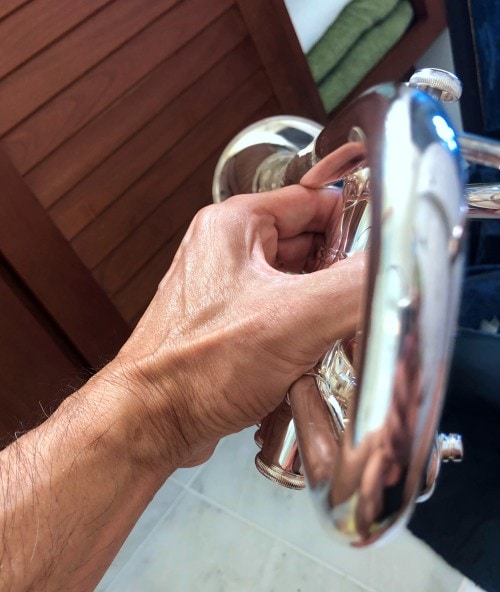
Wrist Positions
To reduce fatigue, try keeping your both wrists as flat as possible. That means the bottom of the trumpet will be tilted slightly to the left so you could draw a straight line from the knuckles on your left hand to your elbow. Try to keep your elbows away from each other which has the benefit of will help you stay open to take full breaths.
How to use your diaphragm
Most athletes use their diaphragm when playing their sports. Like weightlifters grunting to lift heavy weights. Martial arts fighters yell when they strike. Even tennis players are getting in on this trick. As a trumpet player, your diaphragm is the key to your power. If you use yours properly, your trumpet playing will take off to new heights.

Your diaphragm is like a balloon that can expand and contract. Your lungs can do that too, but they are surrounded by your ribcage to protect them. To work your diaphragm, place your hand on your stomach. Breathe in and make your hand move out by expanding your diaphragm without feeling like your lungs are filling up. Once you feel your diaphragm is full, fill your lungs. Then exhale first from your lungs using the strength of your diaphragm. Practice this a few times a day without your trumpet. Then try to play long tones in the middle of the staff. Use your diaphragm to play longer and longer tones. Play long tones softly as long as possible and then long tones as loud as possible while keeping good intonation. Once this feels good, try to use your power to play below the staff and above the staff.
Putting it all together

Take a look at these professional trumpet players at a theme park somewhere in Orlando Florida. Note the women trumpet player’s posture. She is standing tall. Her elbows are away from each other and her body. Her elbows and her trumpet form a triangle, almost a 90 degree angle. This enables her to breathe deeply and play as loud and as high as needed (and did she ever). In a parade, a professional trumpet player has to play powerfully so that the crowd attendees can hear them. Note her wrist positions. Her right wrist is flat and her trumpet is slightly tilted to her left. This allows her left wrist to be flat. These wrist positions allow her to play the trumpet for extended periods of time with less fatigue. It allows her right hand fingers to move easily and swiftly. It was a hot day and her costume looked heavy and warm. She played beautifully throughout the parade. Her tone carried a long way as she played effortlessly upper register notes. Click to learn How to Play High Notes in our post. There’s a “secret” to playing High Notes on the trumpet..
The reason for these positions is that our fingers are moved by the muscles in our forearms. The fingers are connected to those forearm muscles by tendons. These tendons are just like cables on a bicycle brake or gear shifter. They move inside of an outer, protective tunnel or cover. So too do the tendons for our fingers. If you bend a bicycle cable, the inner cable will move back and forth with more friction against the outer cover. This friction will cause wear and tear on the cable. Just like the bike cable, if your right wrist is bent sharply, this will cause the tendons of your fingers to rub against the protective tunnels that protect them.
To play your best, model your posture, wrist, and arm positions like this professional women trumpet player ! She played beautifully, effortlessly, powerfully, and the upper register with ease. She’s a great role model. Please see the trumpet fingering chart.
How To Hold A Flugelhorn
Hand positions for holding a flugelhorn
The flugelhorn is shaped slightly different than a trumpet. When viewed from the players point of view, or what you see when playing the flugelhorn, things look different. First difference you’ll notice is that the mouthpiece tube or lead pipe is on the left. On a trumpet, the mouthpiece tube or lead pipe is on the right. It is also shorter than on a trumpet. It enters the valve cluster near the first valve where a trumpet has the tube entering the valve cluster on the third valve. Second, the bell is on the right. A trumpet bell is on the left. The bell on a flugelhorn is much wider and the tubing is shorter than on a trumpet. A trumpets bell is longer and exits the valve cluster from the first valve. A flugelhorns bell exits the valve cluster from the third valve. This makes holding each horn slightly different.
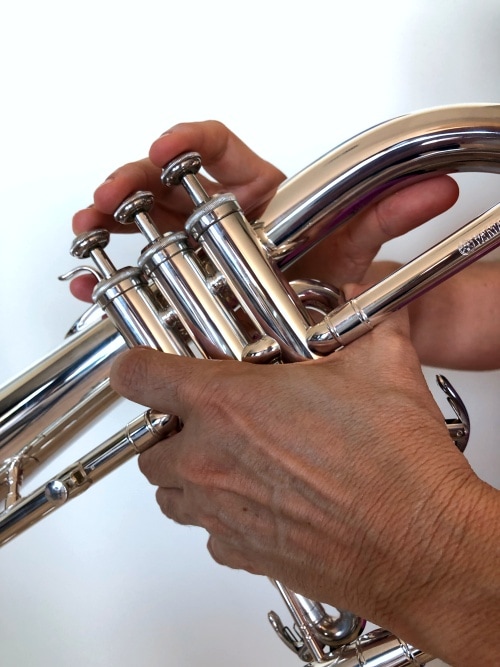
Your left hand grasps the valve cluster similar to how you hold a trumpet.

Your right hand holds the flugelhorn just like it does a trumpet. Your right thumb supports and stabilizes the horn. Your right pinky goes into the finger hook. The only difference is that when you are holding a trumpet, your right thumb is supporting the mouthpiece tube or lead pipe. On a flugelhorn, your right thumb will be supporting the bell. Thankfully, the fingering is the same as the trumpet. Please see the flugelhorn fingering chart below.
